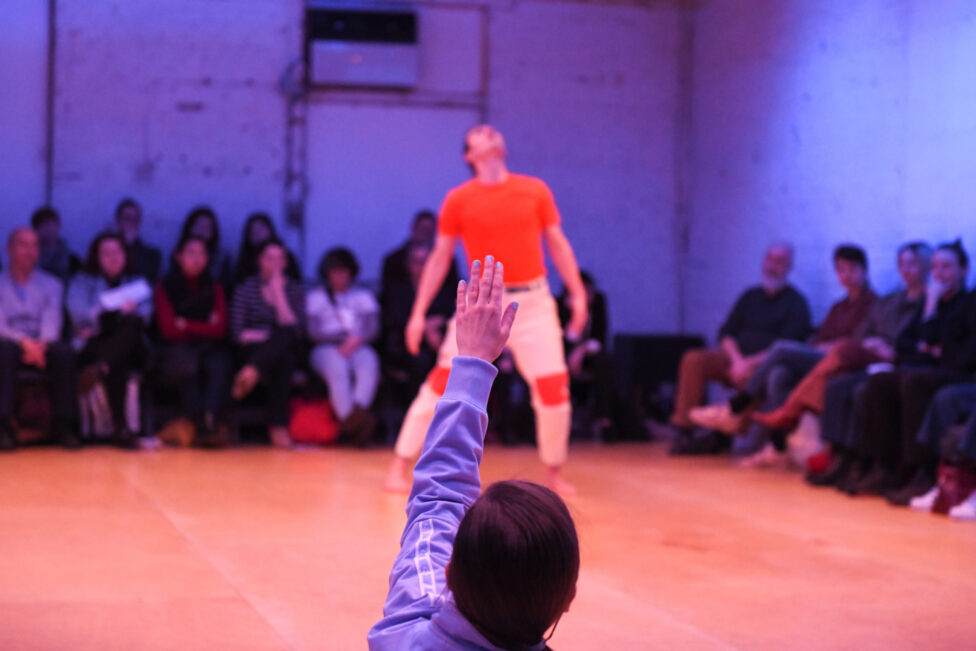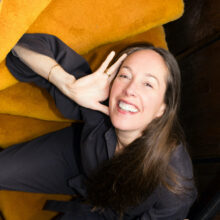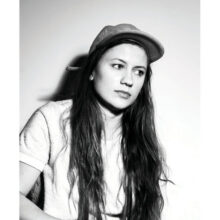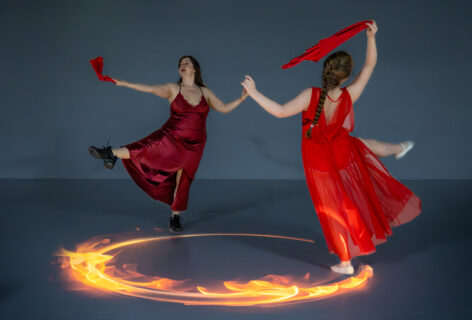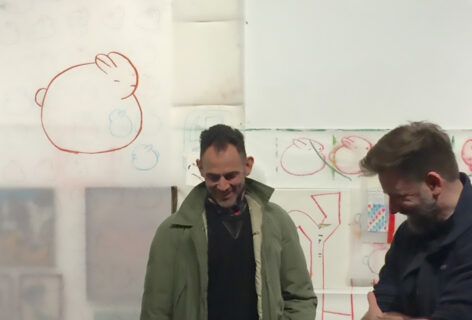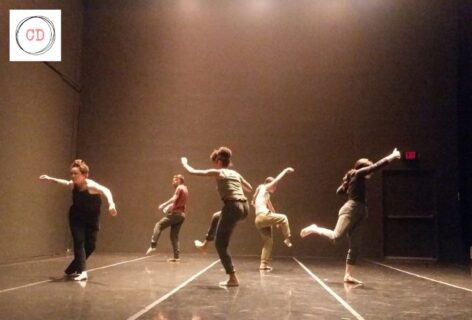Biba Bell: I’m curious about the source improvisations on the video. Neil [Greenberg] shared with me a document with some of the scores and also talked about how some of the prompts developed from previous works; there’s movement through the last four works he has created. And it goes back to what we were talking about earlier: there’s just so much stuff you can’t see on the video. And that’s the difficult stuff, right? I remember you said, what is it to look at the video now versus those early videos.
So I’m curious, in terms of learning your own improvisations, what else goes on in that besides recalibrating steps or the mechanics of the movements? Is there a memory of okay there was something that I was drawing on, an energy, or an impulse, that is also being tracked? That becomes a part of it? Or is that a part of it?
Omagbitse Omagbemi: There are certain improvisations that I recall. Some of them I don’t recall, but the ones I do there’s an energy that I remember. Not necessarily what I was doing, but how I felt, or what I was thinking. When you’re improvising, for me, it’s not like a clear wave of thinking. But when we’re looking at other people, it’s just looking at the movement because you don’t know where they are coming from. So I’m watching from two different sides: to see what I’m doing—me, there is something of me in it of course. When I see someone else, that’s hard for me to do. So I have to figure out what their foot is doing, what their hand is doing, where their elbow is. I have a very different relationship with it.
Opal Ingle: It’s not something that comes immediately. When we have chosen something to study and figure out, there’s the process of getting to know it, which is invariably starting from a physical place. And we take broad strokes. Then eventually if it’s in the piece, we keep going back to things like we did today, like what is the head doing? There is a layer in there, there’s affectation of some kind, some sort of perceived state that is going on, even though the person who actually did the improvisation may not know what that is anymore. We haven’t talked about that a lot.
Kyli Kleven: We haven’t explicitly talked about that a lot. Now we’re just starting to get there.
OI: But there are things like the gaze, when Neil said “we’re going to learn hands,” like the parts of ourselves that we think of as…
KK: Ourselves.
OI: …like we can’t get away from how much our face and our hands are us. But if we’re really trying to replicate what someone else’s face and hands are doing then we have to study emotionality to try and figure out. And I have never been one to remember what that person was experiencing. It’s all gone. It’s gone that day, there it goes.
OO: There are some things where I’m like, oh I kind of know that maybe, because she does that a lot. So I kind of know, but I really don’t.
OI: That’s true. That’s true.
OO: And it’s also improvisation. There’s basically no thinking. I mean there is thinking about maybe what it is you’re doing, but how we have to think about it when we’re improvising and then look at it and try it, it’s very different.
BB: Of course.
KK: At least for myself, I really have to watch and try as hard as I can not to see affect, for as long as I can. Officially, when I first started this process with you guys (I came in later), and was learning Neil’s leg phrase, which we no longer do. All I see is this [movement].
I guess I haven’t learned a lot from video so what I’m used to in a process is someone being like “could we do something like this” and it is usually an affective prompt. Then we kind of set something together based on that sort of container of an idea. But we don’t start with “let’s learn this exact step,” you know what I mean? So I had to be like let me just see, right foot left foot right foot left foot left foot left foot right foot left foot, which is like something I haven’t done since I was in college.
BB: Like learning in front of a mirror how to replicate.
KK: Right, the value system is going to be the numbers of things and where they go, first, and that’s really unusual.
OO: Also what I see is not what she sees, and we’re all trying to be like this is what they’re doing. Sometimes I don’t see that, I see something else. So I can see just pieces—maybe it’s just the pieces I want to see. And then there are the pieces that someone else sees and I’m like…
OI: …that didn’t happen…[laughter]
OO: …I didn’t see that at all! Neil would see a curve and I’m like, I don’t see that curve. I see something else. Then it’s helpful to have a third person because then we just all see three different things. You want to try to do what the person’s doing on the screen at the same time, but there’s a part of me that’s like it’s okay not to. You know? [laughter] I don’t want to say giving up, but it’s really okay if I’m not. Even if it’s your improvisation, it’s going to be different.
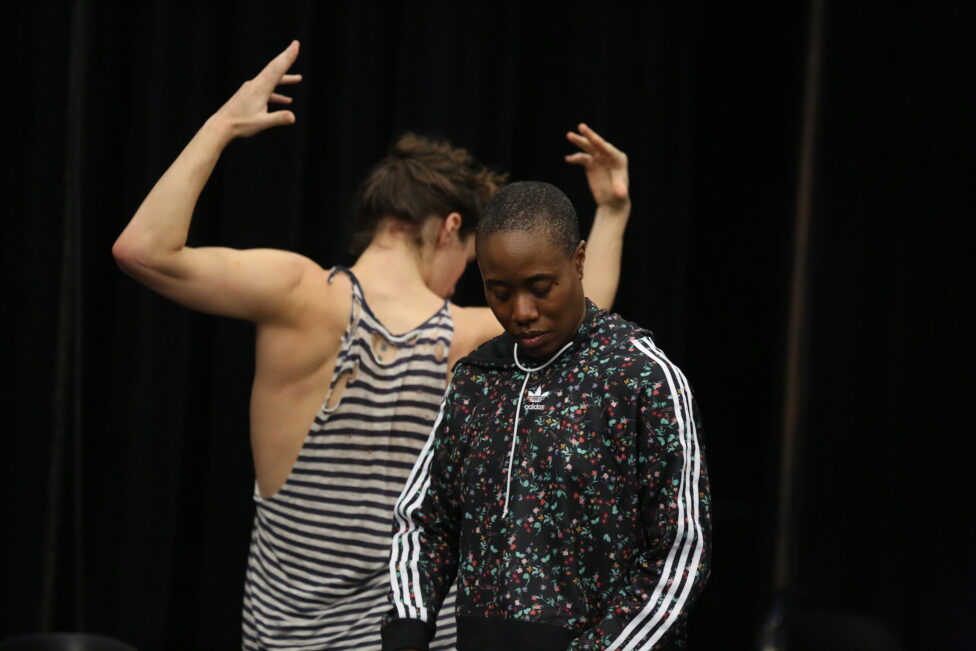
photo by Chris Cameron
ID: Omagbitse Omagbemi in the foreground in a black jacket looking down with Opal Ingle in the background facing away and both arms cactused to the right, both in a studio in front of a black curtain.
OI: I do appreciate that there is an earnest attempt to really do what the person on the video is doing, but also a real clear understanding that you’re not going to be like them, but you know you were, like you said, not giving up.
OO: You’re not giving up, you’re like “okay!” [laughter]
OI: But you’re still earnestly trying to do it even though you know you’re going to give up. Everytime [laughter].
OO: Well, yeah, you’re not going to move the way you think you see.
BB: Neil talks a little bit about the phrase he uses, “filling it with body.” I was thinking about that in terms of the container. So looking back at those original improvisations, were you doing those improvisations that were then learned, also?
KK: We did some clear ones with me that I learned.
OO: You did a solo improvisation!
OI: You did the two…we did a number of improvisation studies without videotaping. Then we had one taping day before Kyli joined and then we had a second one after. So it was really only two rounds of gathering material. Neil had some earlier tapes that he had just videotaped himself.
KK: You guys had solo materials that I learned.
OO: But there’s a difference with the piece I did last time [This (2014)]. That was the first time he was working with our improvisations, as opposed to just his and trying to break those down. So, it does make a difference who is in the room, what they’re offering, how things shift, take shape, and really trying to be in Neil’s body as opposed to trying to be in Kyli’s body. It’s very different. Or my body is.
KK: Yeah, it feels like a real memory task and sometimes not. Or at least there was a period where I wanted to get good at this. And now I’m not doing that anymore. I’m trying to get more accurate at this, but not do it well. Does that make sense? My self-evaluation is shifting a little bit? Whereas I feel like there was a period where Neil was “tone down the bursts,” meaning don’t make the movements more dynamic than they were in the source improvisation. And if we’re looking at hands, he really means it, you know?
BB: What does that mean?
KK: He really means the video material. In a super serious way, it’s not just the affect, it’s not just the steps. It’s also the level of expertise with the steps, the level of self-evaluation with the movement. You wouldn’t do it as if you know it and you’re really good at it. You would do it as if you’re improvising it, or as if you were experiencing it.
BB: And for the first time.
KK: Right. Meanwhile all these things are playing in your brain.
OI: It’s one of those tasks that’s just always impossible. Everything about the momentum inside and outside of your body led you to this point, to be able to initiate the way you just did, and that’s not going to happen again. Especially when you transfer it to someone else’s body. Let’s get as far as we can into it…
KK: But not polish it.
OI: So you know it well enough to experience it. Which is what I want to do all the time anyway. With set material.
OO: That’s, like I said, not wanting to give up. But give up. You know it’s not going to be possible to do exactly. And I’m always thinking it is possible. You can do that. But at the same time, no. It’s not physically possible because then I go back to the video and see, wow, that’s not what’s happening. So you have to keep going back, which I find helpful and annoying at the same time. Because I want to keep going!
KK: Yeah, same.
OI: I haven’t really thought about this, but the biggest thing missing from doing something the way someone else does in the video is the fact they don’t have to think about what they’re doing.
OO: Yeah, because they’re improvising.
OI: They don’t have to think of anything.
BB: It’s interesting to think of doing a series of improvisations without the video, and then introducing video. Then choose a taping and say okay, this is going to be the one that we’ll continue on in this process.
OI: I didn’t realize that was the way it worked until… Because we were just improvising for a while, and then the beginning of a week Neil was like, “so you want to do a taping? We’re going to do a taping on Wednesday.”
OO: Oh yeah he did say that! And the first time it’s like, uh…
OI: I asked, how many tapings do we do? He said one, maybe two. I was like oh, high stakes! [laughter]. This is the piece. You’re making the piece today.
OO: It’s weird because I never thought about it as going out of something else into something else. I don’t know why. They are different but I don’t see them as different. It’s just something new. Because there is a change I’m making, but I don’t see them so separate. I just see it, and move a different way. As opposed to wow, now I have to do Opal.
OI: I was talking to James [composer James Lo] the other morning and he said, “I’ve never seen other artists work the way dancers work.” Which is always kind of an interesting discussion but what does that mean? [laughter] For him, the choreographer really does this complete back and forth, where you did three of these things, now just do two of them. Actually do three. And then goes back and cuts it all together. And the next day goes back, puts them back in, and asks for eight of them. James was just like, that would drive me crazy.
OO: I mean, it drives me crazy!
OI: The hardest part for me is not the act of adding or subtracting. It’s that you get attached to the thing. And I’ve tried to come to terms with this before, but you work on something and you figure it out, and then the choreographer cuts it or edits it out and that hurts. Why am I hurt, I don’t care about this?
OO: I feel like, uh, oh, you just fucked up my flow. I had something!
OI: You’ve acclimated to the way it’s like a wordless story about how it fits with the other things. I can’t explain my understanding of how I know to go from this mode to that; from Omagbitse’s floor phrase, to doing stomping. But we’ve done it enough times that I understand it, so I can do it and I don’t feel like I have to think about how I’m changing modes. I know about it. But then it gets chopped it up and, fuck! Now I don’t know, it’s half as long, and so then the shift is different all together.
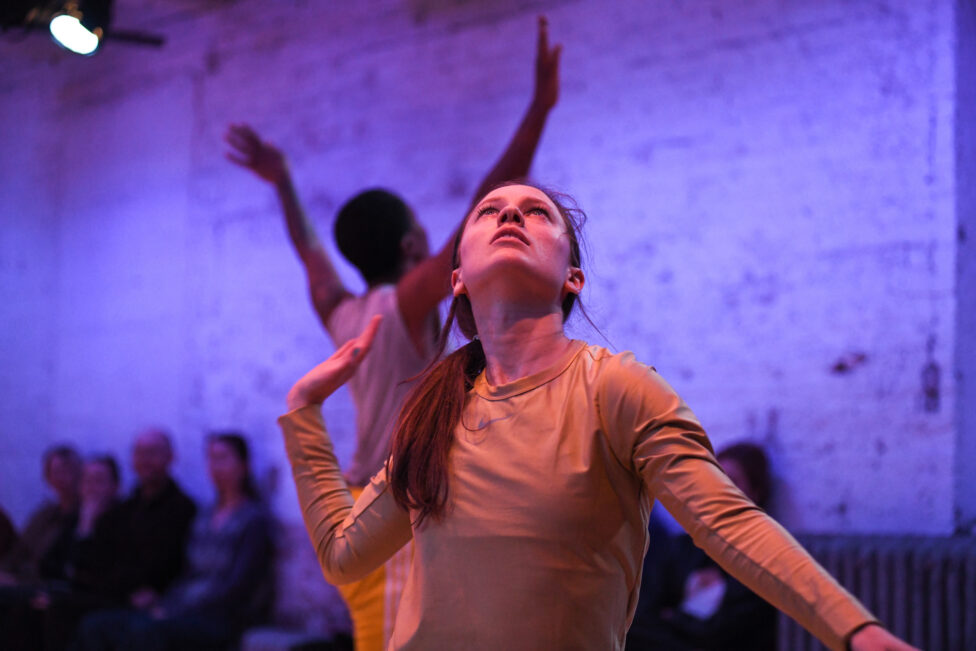
photo by Paula Lobo
ID: Kyli Kelven’s torso twisting with on arm bent behind and the other outstretched in front, in a gold top, wide-eyed looking up; and Omagbitse Omagbemi in the background against purple light on the white wall of the Chocolate Factory theater.
OO: We’re not trying to smooth it out.
BB: It stays in the structure.
OO: It’s also the thing where we see things differently and we understand things differently. So sometimes I’m trying to understand what Neil’s “breaking” is and I understand what my idea of breaking is, but then sometimes they’re not the same.
OI: And the way I’m talking about it depends on being in the fiction and being in the non-fiction. And it’s easier, clearer to me, when you’re doing something that’s fiction, and then you’re like: I’m breaking into not being in fiction land. That seems clear but then there are a lot of phrases that are…
OO: Not so fiction.
KK: Middle fiction.
OI: Middle-ish, or even super casual. Like I’m in the room just doing this thing and I’m looking at you the whole time anyway. So what’s breaking from that? Like I just stopped moving but nothing really changed about my state.
OO: We’re trying to figure that out, the breaking part of it. Because I can feel like I’m breaking, and it doesn’t look like I am. So what is it that you see? And does it always have to look the same? Because I understand that, you’re in the thing, and then you change it.You see somebody and then go into another thing. But is it always a transition?
KK: We’ve talked a long time about the way it happens, too, like the transition in and out or partially in and out. We have these stationary self-aware poses. Rests, sort of.
BB: When you’re on the sides?
KK: When we’re on the sides, yeah.
BB: And you’re looking at each other.
KK: Where maybe a hand is a fiction, and the rest of the body is non-fiction. Or your head is non-fiction, but everything else is somehow modeled a little bit. Then how do you rearrange that, either like in segments or as a cross-fade, or all the ways change can happen?
OI: Yeah, we haven’t quite figured all of that out. But then it’s gonna help being in the Chocolate Factory and figuring out the actual interaction in the space, informing the way that you are modeled, which also will affect the way we’re engaging in the thing itself. But not that dissimilar from the way I feel when I’m an audience member. You realize you’re on stage, and performing attentiveness with your body position. And (this is because I’m self-conscious), if I need to shift, but the show is quiet or someone is close to you, you wait for a little bit and then you can shift. So, I’m also spinning this wheel of having to pay attention to when I need to return.
BB: And what happens next? I was wondering when the “break” happens, do you think forward or evaluate back? Or just a different sort of time, placed on the time continuum?
OI: That’s the part that I find the hardest about having breaks, when you have that timelessness inside of the structure. Whatever is happening will take as long as it needs to.
OO: I think I learned this from Ralph Lemon who said, “You have rules, you have structure. You can always break it and not do it.” So I always play with that. Maybe I’m not going to wink [in the performance] or maybe I will, but it will be in a way that you don’t know what it is. Sometimes I have to be able to give myself that permission because everything gets so, I have to do this but I can’t.
KK: There were a few students [audience members at the MANCC showing] who, if I would look at them too directly for so long, they want to hold my gaze longer because they feel like they’re supposed to. And so you have to say, “no, that’s not what it is. Actually, let me direct you towards the casualness of what I’m trying to do.”
OI: Bringing you in, pushing you out a little bit.
KK: That’s why we should perform in front of 50 people every week.
BB: I think that’s a great idea. I was too thinking about looking at people while you’re performing and having that interaction. Carla [Peterson] was talking about aggressiveness and what/how it’s different. And it is. There’s so much that can happen because there is a kind of communication that is going on with just looking at someone—there’s an exchange of energy. There’s a different sort of awkwardness that is being introduced that can also be strange and difficult to manage and then also get to the thing on time.
OI: That’s the part that I really want. That’s why I would want to have people at every rehearsal until the show to really engage with that awkwardness.
KK: And to feel it as a negotiated space. That’s the word you used earlier and that’s exactly what it’s like. It’s negotiated or there’s a liminality here.
OO: Because even with the students, it’s always an awkward thing. In general, I don’t want to come at a person like, “I want to show you this even if you don’t want to see, ok?” I look at someone, they’re not looking at me. I can either wait until they look at me and be like okay, which I find interesting because sometimes they’re not looking at me. That’s the negotiation.
BB: There’s looking at a stranger, or somebody you know, or somebody that you know of, all those other things will happen.
OO: So sometimes I don’t know if I want to wink at them, because then that seems like I’m trying to force something on you.
OI: I bet it’ll be easier.
OO: I think because I wink without the smile it’s a little bit unrecognizable.
KK: The winks are really good.
BB: “I’m looking at you” or “I’m looking at you looking at me,” or “I’m looking at you to show, to say, it’s okay for you to look at me,” or as an invitation to look at me.
OI: Well, it certainly won’t be as shocking as the first showing [at MANCC]. Definitely that’s going to be the hardest performance that we ever do in this series. Because it’s really an engagement: looking at different people, different people are looking at you every time. It’s hard for that not to feel new.
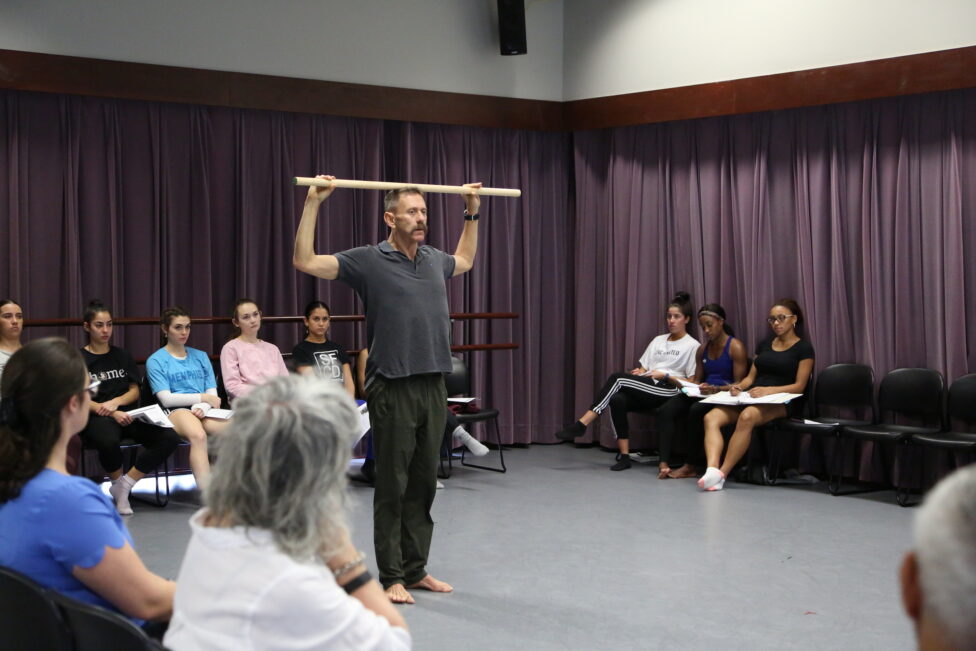
photo by Chris Cameron
ID: Neil Greenberg standing with both hands holding the ends of a wooden rod balanced on his head in a rehearsal studio at MANCC with lavender floor-length curtains on the walls, with an audience of students seated in the round watching.
KK: Does that feeling ever feel divorced from the tasks or the things that we’re doing to you? And if so, does it feel that way, in a way that’s interesting?
BB: It does feel like another formal layer choreographically. But I think that the way it happens and lives itself out doesn’t feel separate. It feels interesting and in relationship to what you’re doing.
KK: Would it feel interesting if it was separate?
BB: If it was divorced?
KK: I’m wondering how far we’re gonna go.
BB: It’s hard to say, but it would feel more concept-based and less embodied.
OO: But it would change the timing of everything.
BB: Do you feel like there is permission to find a way to not have fidelity to what it was before—just a new thing that’s going to develop into something? Or is what you’re talking about just going off somewhere and not staying true and tethered to the video?
OO: For me, I have to, in my head, see the video to go off. Because sometimes I just forget where the hand is.
OI: I don’t know if they would say it’s permitted or not. I think deviation is inevitable. We all have those moments where we are finding a way, like we’re just riding the piece now. And there are other factors so we’re not just focusing on doing the phrase exactly right. That gets lost and now we’re just doing it.
OO: We don’t go too far.
KK: Definitely. When we go too far, Neil’s like, “Hey, you’re going too far.” I don’t think of it as the word permission at all. We have an agency to do the tasks. But the integrity of the thing is based on like proximity to it.
OO: I feel like we could go far, just we’ll always have to come back. [Neil] will say “pop up.” At first, I have no idea what he means. But I think, I’m just going back to Opal’s phrases. I can have my moment but then go back to what the thing was, and the “pop up” happened. So it’s not all, up up up up up. So I think we do have permission as long as we can come back.
BB: Know when you’re making that choice.
OO: Yeah, you’re making a choice.
BB: A lot of the movement is idiosyncratic. The process moves through this abstraction machine a little bit because of the video. I was just curious in terms of the doing, if it lands? Do they land? Or does it just sort of stay kinetic and mobile and potential?
OI: When I think about the referent, it is sticky. It’s like what makes it more prominent or less, or this is what you’re thinking about every time you do this thing.
KK: What do you think about when you pick up the Nutcracker? That feels like such a reference.
OI: It’s interesting because I don’t think about the Nutcracker at all.
KK: I know you’re not doing the Nutcracker dance. You are miming something.
OI: Right, but then because that wasn’t the prop. It was a mic. So I wasn’t thinking about the mic as a mic either. Then the fact that it’s the Nutcracker doesn’t influence…
KK: No, no, I mean what you do. Not the Nutcracker itself. I mean, you’re doing something that is so solid.
OI: It changes a little bit. I don’t recall what book it was but there was a children’s book I had when I was a kid, where there was like a banished someone that had the stick with the little bag on it.
KK: You’re so doing that [laughter].
OI: But I wasn’t doing that originally. I don’t recall thinking that way when the person on the videotape did the thing, but I feel like that shows up occasionally. Well also because Neil named it “happy traveler” or something.
OO: Neil has a lot more references.
KK: It starts out as that thing and then it’s like clearly not that thing.
OI: That’s the thing about memory. You’re just like, is that coming from me or is that coming from Neil naming the thing? And I don’t know where it came from. I can’t unstick it from the thing entirely, but how did it get there?
OO: Yeah, he has more references than we do. Because were you thinking monster/robot when you were doing that?
KK: I was thinking k-k-k-k-k-k…
OO: So there was no, I will try, now I will be a robot, here I go.
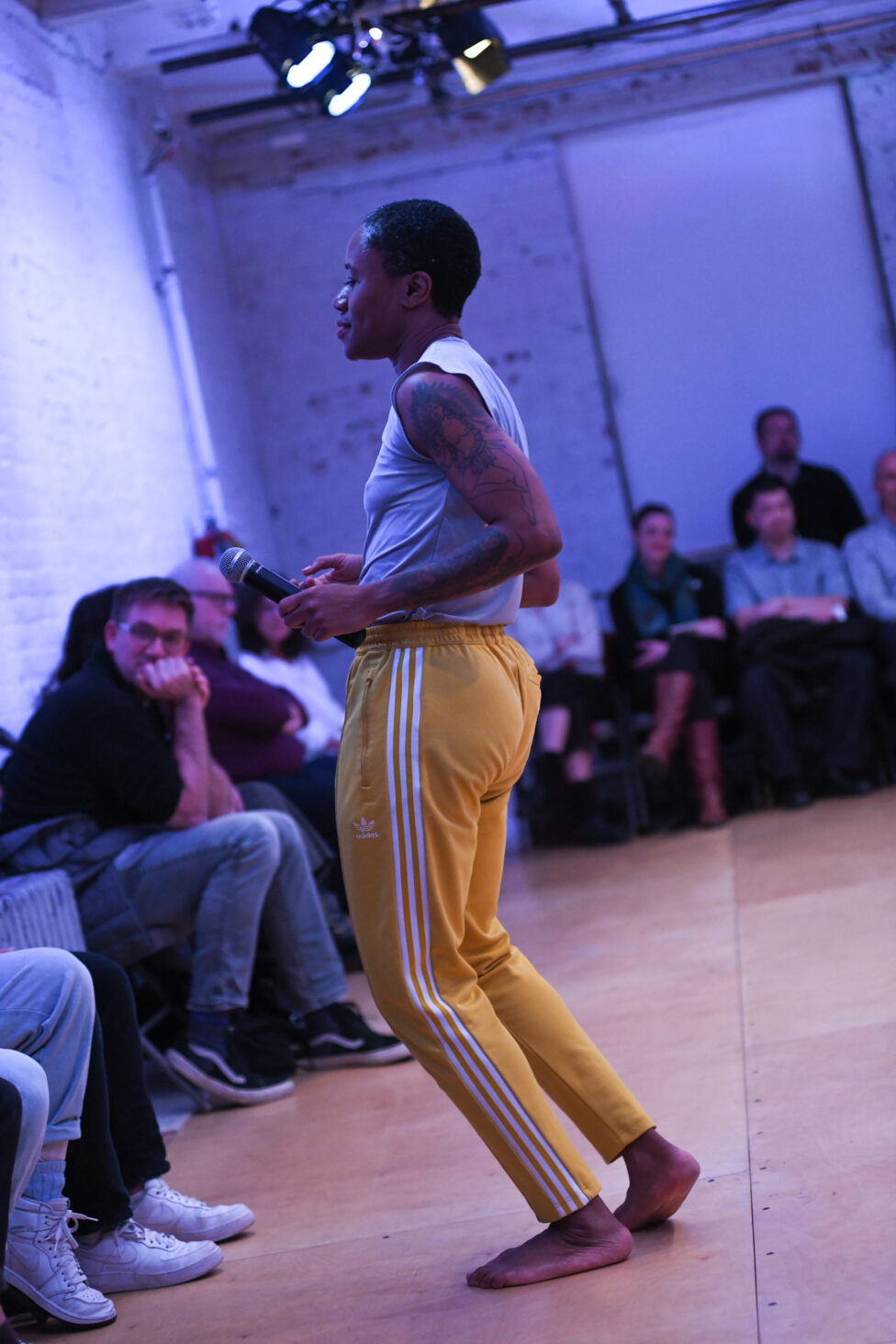
photo by Paula Lobo
ID: Omagbitse Omagbemi in a grey tank top and yellow pants with three white Adidas stripes holding a microphone in front of an audience in the round at the Chocolate Factory theater.
BB: I brought up the word “archetype” yesterday, that’s maybe when you sort of brush up or get into the zone of something like that and then it moves away.
OI: It’s present for me and relates to the question of shifting between things, an understanding of what you’re shifting from and to that you assigned at some sort of boundary, to understand what it is. And in some ways you can call that boundary or archetype, whether it’s unanimously known or you just made it up.
KK: I agree that the thing is a collage, like we multitask with material. Just like we multitask with interchangeable objects. You can use the microphone as a microphone or maybe it’s a dildo. It’s like all sort of casually interchangeable. Some kind of casual sprinkling of multitasking material and archetype too. Just be this thing over here but this thing could also be like this, over here.
OI: When you’re in a dream, you’re like I’m with Omagbitse but Omagbitse is also my dad. But the dream goes on and it’s like Omagbitse is my dad for a long time.
OO: And it’s also Omagbitse, but you can’t actually see the face.
BB: Are you gonna have a dildo as one of the objects?
OO: I don’t know why Kyli said that, maybe because I put it between my legs.
KK: We literally have a section called the “penis dance.”
OO: —but no one knows that.
BB: And the floss.
OI: Oh, the ass floss? Yeah, the audiences are primarily younger and sexually shy.
OO: And that was not sexual when I did it.
BB: It doesn’t feel sexual.
OI: I mean, I’m just trying to put myself in a 20-year-old brain and everything is sexual. Then when you actually do put something between your legs…but yeah, none of it feels sexual to me.
OO: But if I didn’t hear “penis dance,” you wouldn’t think that. But how you hold it is very different than how I held it. It’s more vague. Do you think of it as a phallic symbol?
BB: I mean it is, but I didn’t think of it as a penis necessarily. It could be the action of you just having it there.
OI: Especially at that point because during the whole microphone section there’s a setup of how it is/how you interact with it. I don’t know that I even saw the video of penis dance before Neil said it was a penis dance. The first time we learned it, he was like, “Let’s learn the ‘penis dance’” and then put it on. So now I’m gonna look for the penis.
BB: It could be crotch dance, penis dance, cunt dance, it could be…
Well, this has been really great, thank you.

